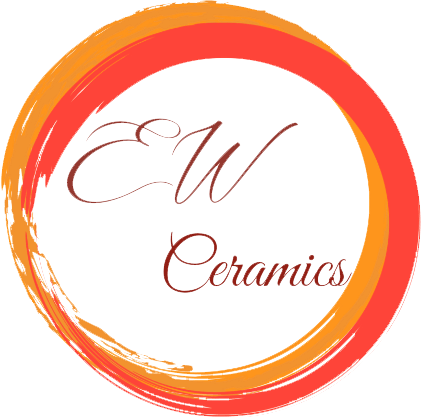Avenida de Berna 45A, Lisboa,
www.gulbenkian.pt
Como ceramista amante das artes, residindo parte do ano na Holanda, tenho tido a oportunidades de visitar museus e centros culturais em diversos países do continente Europeu. Tendo siso professora universitária por muito anos gosto muito de escrever e relatar experiências tidas com estas visitas, como uma forma de inspirar outros artistas ceramistas e valorizar a beleza dos museus e centros culturais.
Em 2021, ao final do isolamento da pandemia de Covid 19 na Europa, fiz uma visita ao belíssimo Museu Calouste Gulbenkian, situado nos Jardins Gulbenkian, próximo a Praça de Espanha, em Lisboa, Portugal.
Calouste Sarkis Gulbenkian, apelidado pelos seus conterrâneos de “meus 5%”, foi um grande empresário e filantropo de origem Armênia e nacionalidade Inglesa, nascido em 1869, em Istambul, na Turquia. Ele formou-se em engenharia em Londres pelo King’s College, tendo vivido na Inglaterra, na França e em Portugal.
grande importância no mundo dos negócios, pois favoreceu a exportação do petróleo do Oriente Médio para os países do Ocidente, recebendo a percentagem de 5% dos contratos por ele negociados. Calouste faleceu em 1955, em Lisboa, Portugal.
O Museu Calouste Gulbenkian, fundado por ele em 1969, apresenta uma das coleções particulares mais importantes do mundo, englobando obras de arte desde o antigo Egito ao século XX. As cerâmicas e objetos decorativos, provenientes principalmente do Oriente Médio – antiga Pérsia, Turquia, Síria, Ásia Central e Egito – são datadas dos séculos XII ao XVIII. Os objetos no museu são organizados de acordo com a sua origem geográfica, seguindo uma linha do tempo.
As an art-loving ceramist, living part of the year in the Netherlands, I have had the opportunity to visit museums and cultural centres in several countries on the European continent. Having been a university professor for many years, I really enjoy writing and reporting experiences as these visits, being that a way to inspire other ceramists and artists and to enhance the beauty of museums and cultural centres. In 2021, at the end of the Covid 19 isolation pandemic in Europe, I visited the beautiful Calouste Gulbenkian Museum, located in the Gulbenkian Gardens, close to Praça de Espanha, in Lisbon, Portugal. Calouste Sarkis Gulbenkian, nicknamed by his countrymen as “my 5%”, was a great businessman and philanthropist of Armenian origin and English nationality, born in 1869, in Istanbul, Turkey. He graduated in engineering in London from King's College, having lived in England, France and Portugal. As entrepreneur Mr. Gulbenkian was of great importance in the business world, as he favored the export of oil from the Middle East to Western countries, receiving a percentage of 5% of the contracts he negotiated. Calouste died in 1955 in Lisbon, Portugal. The Calouste Gulbenkian Museum, founded by him in 1969, features one of the most important private collections in the world, encompassing works of art from ancient Egypt to the 20th century. The ceramics and decorative objects, mainly from the Middle East – ancient Persia, Turkey, Syria, Central Asia and Egypt – date mainly from the 12th to the 18th centuries. The objects in the museum are organised according to their geographic origin, following a timeline.

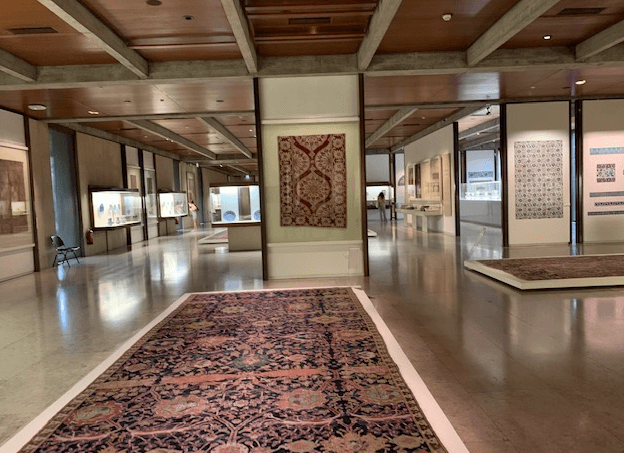
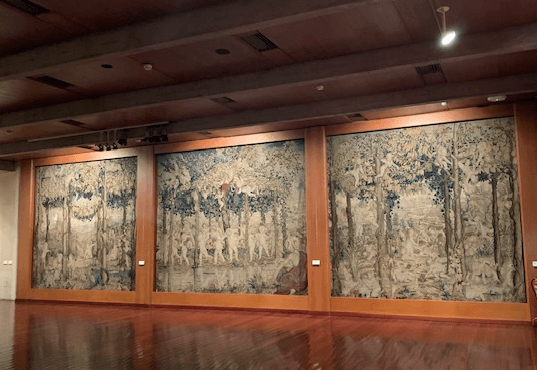

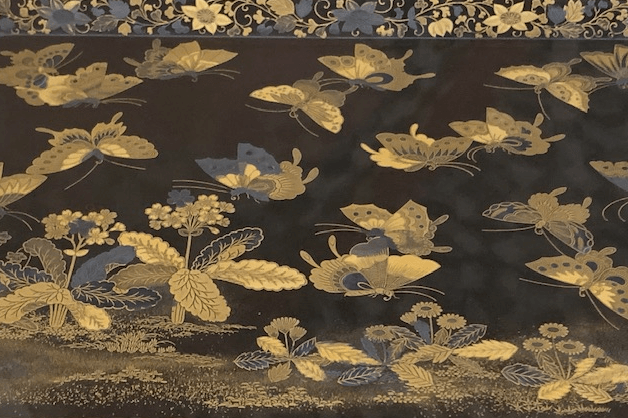

As cerâmicas
As cerâmicas Italiana e Otomana (Império Turco) partilhavam uma estética comum com suas raízes no Oriente Médio, sendo uma de suas características a esmaltação em vidrado branco puro, com desenhos de diversas cores. O 1o. vidrado a base de estanho que se tem conhecimento surgiu no Iraque no séculos IX, atribuindo-se a este surgimento uma contrapartida ao aparecimento da porcelana Chinesa. Já as cores surgiram um pouco mais tarde, inicialmente com o azul cobalto, e a seguir com a aplicação de pigmentos com reflexo metálico sobre o esmalte vidrado. Estas técnicas e seus efeitos na cerâmica foram, nos fins do século X, levadas do Iraque ao Egito, difundiram-se para a Pérsia, e mais a oeste para a Espanha e a Itália, originando as pecas muito apreciadas pintadas em cerâmica maiólica.
The ceramics Italian and Ottoman (Turkish Empire) ceramics shared a common aesthetic with their roots in the Middle East, being one of their characteristics pure white glazed enamelling, with designs in different colours. The first tin-based glaze that is known emerged in Iraq, in the 9th century, attributing to its appearance a counterpart to the appearance of Chinese porcelain. The colours were presented a little later, initially with cobalt blue, and then with the application of pigments with a metallic reflection on the glazed enamel. These techniques and their effects on ceramics were, at the end of the 10th century, taken from Iraq to Egypt, having spread to Persia, and further to the west, arriving in Spain and Italy, originating the much appreciated pieces painted in majolica ceramics.
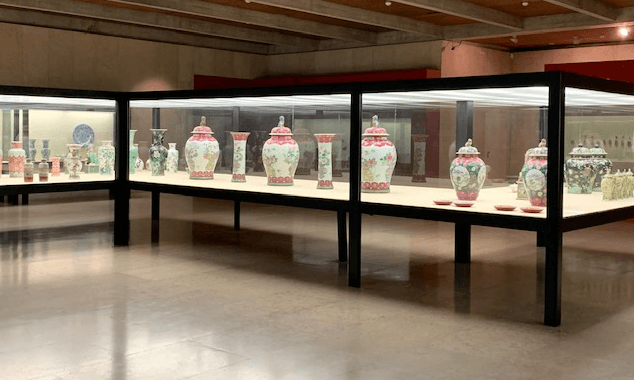
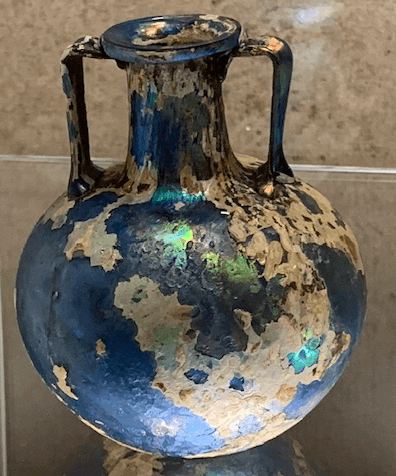
Vaso-urna parta (Norte do Ira), com ornamentação vidrada constituída por uma cadeia de medalhões e 4 mascaras (Ática séc. I a.C.).
Parthian urn vase (Northern Iran) with glazed ornamentation consisting of medallions and 4 masks (Attica 1st century BC)

Taça com soberano entronizado e pares de esfinges (Pérsia, séc. XII)
Cup with enthroned sovereign and pairs of sphinxes (Persia, 12th century)
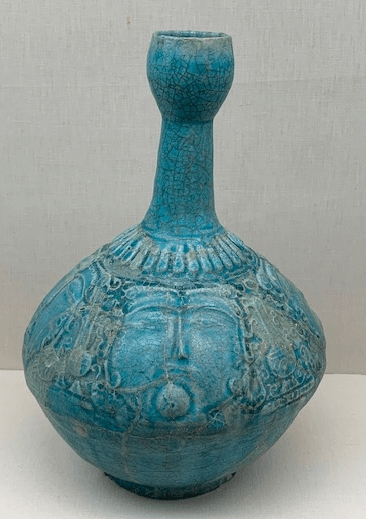
Garrafa com 4 rostos (Pérsia, séc. XII)
Bottle with 4 faces (Persia, 12th century)
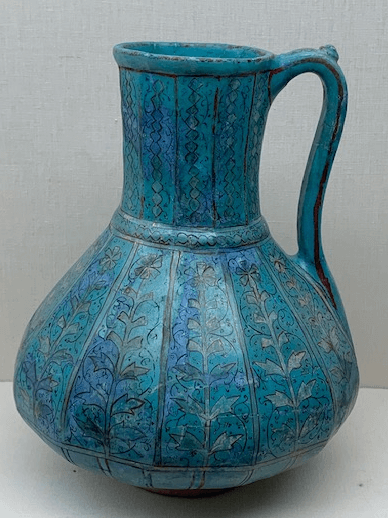
Jarro com motivos florais (Pérsia, séc. XIV)
Jug with floral motifs (Persia, 14th century)
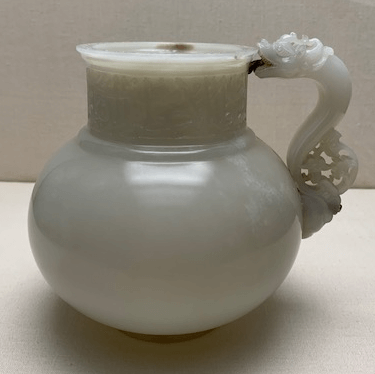
Jarro feito para Ulugh Beg em Jade branco (Asia Central , séc. XV)
Jug made for Ulugh Beg in white Jade (Central Asia, 15th century)
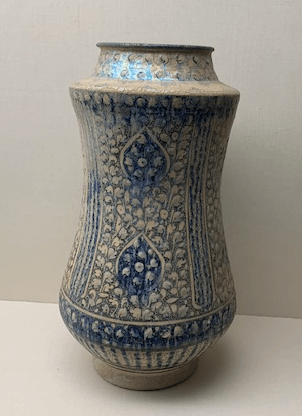
Jarro com motivos de folhas (Pérsia, séc. XIV)
Jug with leaf motifs (Persia, 14th century)
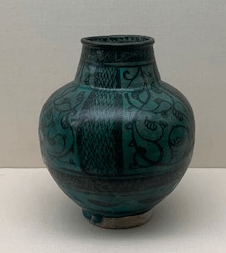
Vaso de gargalo largo e curto decorado a negro sobre fundo turqueza (Asia Central , séc. XI V)
Vase with a wide and short neck decorated in black on a turquoise background (Central Asia, 14th century)
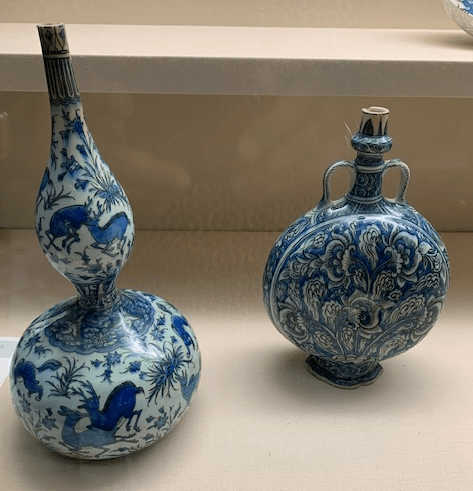
Garrafa com veados e garrafa de peregrinação (Pérsia, séc. XVII)
Bottle with deer and pilgrimage bottle (Persia, 17th century)
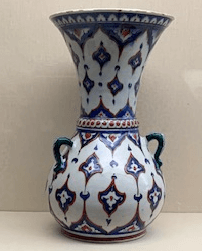
Lampada de mesquita
Mosque lamp
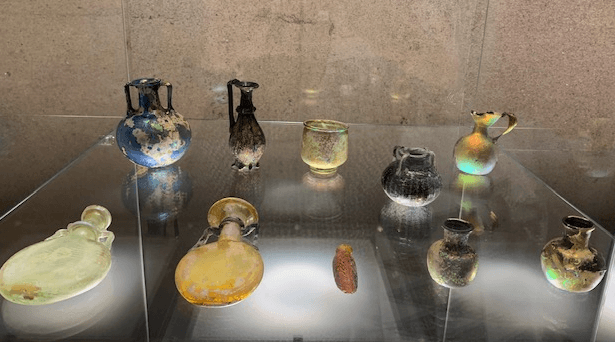
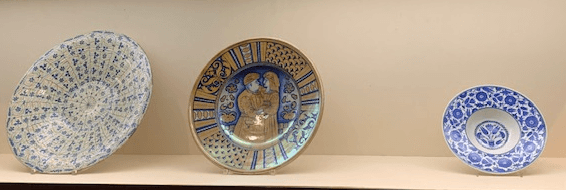
Pratos fundos (China, séc. XV)
Deep plates (China, 15th century)
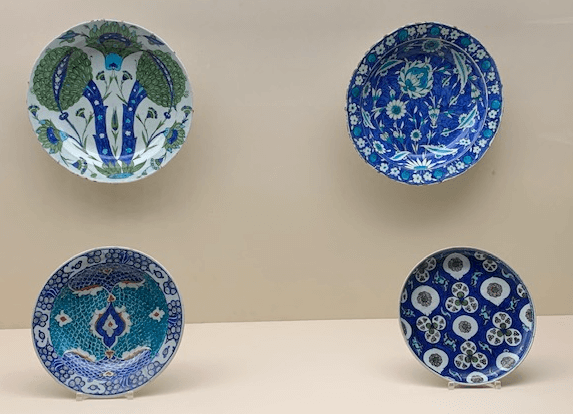
Pratos fundos com motivos diversos de bulbos (Turquia, séc. XVI)
Deep plates with various motifs of bulbs (Turkey, 16th century)
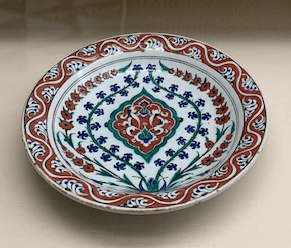
Prato fundo com medalhão central (Turquia, séc. XVI)
Deep plate with a central medallion (Turkey, 16th century)

Prato fundo com flor de lótus (Turquia, séc. XVI)
Deep plate with lotus flower (Turkey, 16th century)
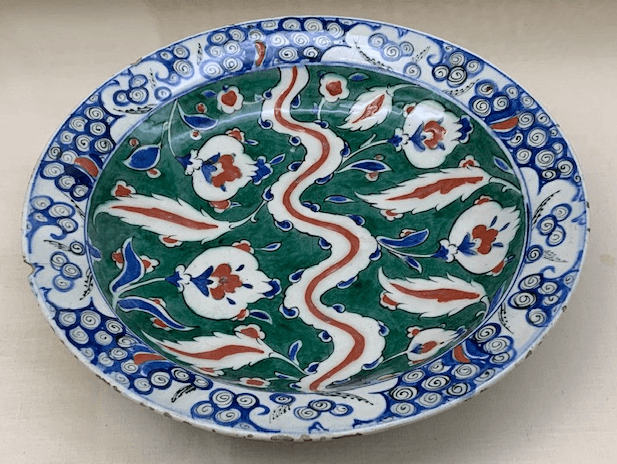
Prato fundo com (Turquia, séc. XVI)
Deep plate with lotus flowers (Turkey, 16th century)

Prato fundo com flores de lótus (Turquia, séc. XVI)
Deep plate with lotus flowers (Turkey, 16th century)
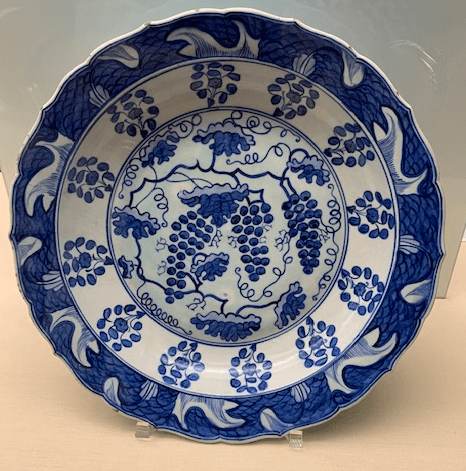
Prato fundo com uvas e motivo de vagas e rochas (Turquia, séc. XVI)
Deep plate with grapes and motif of waves and rocks (Turkey, 16th century)

Prato fundo com flores (Turquia, séc. XVI)
Deep plate with hyacinths and deep plate with trees (Turkey, 16th century)
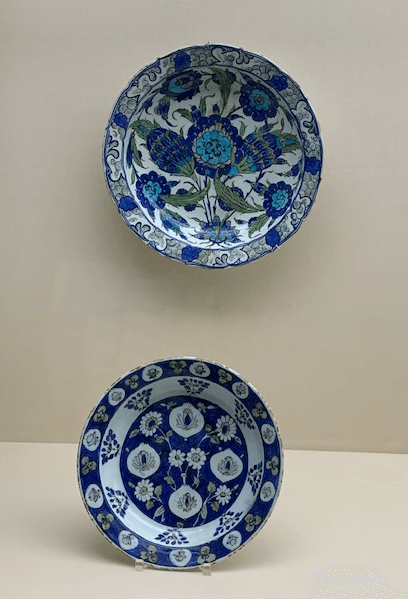
Prato fundo com Jacintos e prato fundo com arvores(Turquia, séc. XVI)
Deep plate with hyacinths and deep plate with trees (Turkey, 16th century)
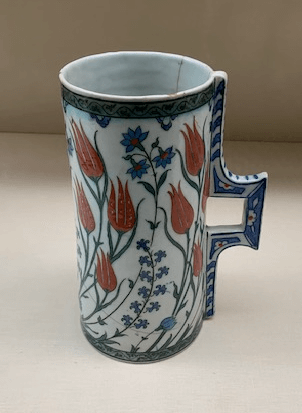
Caneca com tulipas (Turquia, séc. XVI)
Mug with tulips (Turkey, 16th century)
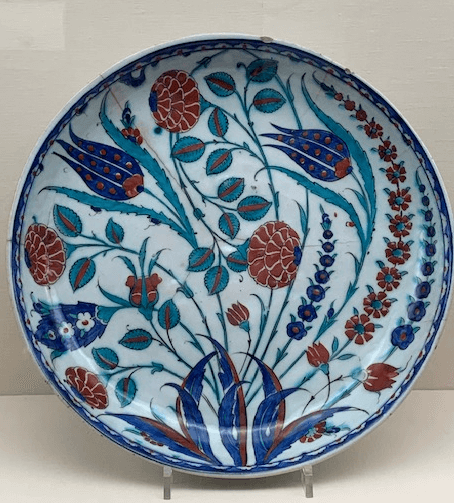
Prato fundo com tulipas com pintas (Turquia, séc. XVI)
Deep plate with spotted tulips (Turkey, 16th century)

Prato fundo com tulipas (Turquia, séc. XVI)
Deep plate with tulips (Turkey, 16th century)
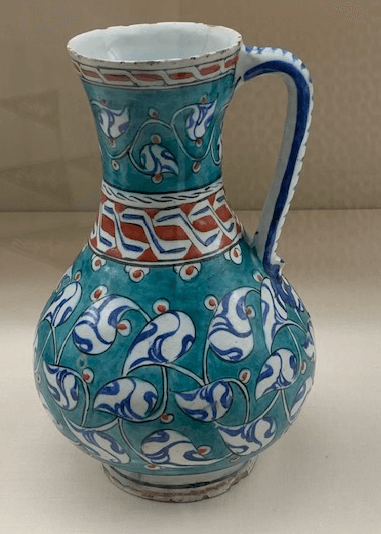
Tigela com escamas (Turquia, séc. XVI)
Bowl with scales (Turkey, 16th century)
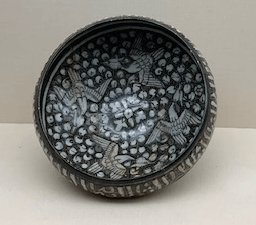
Tigela com veado no jardim (Persia , séc. XVI)
Bowl with a deer in the garden (Persia, 16th century)
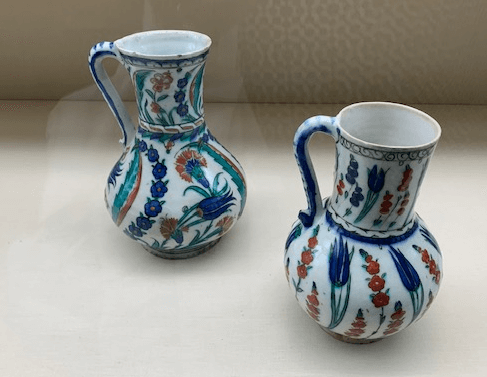
Jarros com tulipas e cravos (Turquia, séc. XVI)
Jugs with tulips and carnations (Turkey, 16th century)
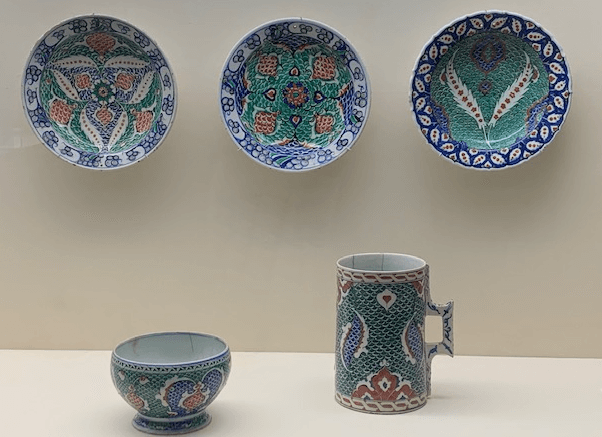
Pratos fundos com tulipas e cravos (Turquia, séc. XVI)
Deep plates with tulips and carnations (Turkey, 16th century)

Jarros com folhas curvadas e escamas (Turquia, séc. XVI)
Jugs with curved leaves and scales (Turkey, 16th century)
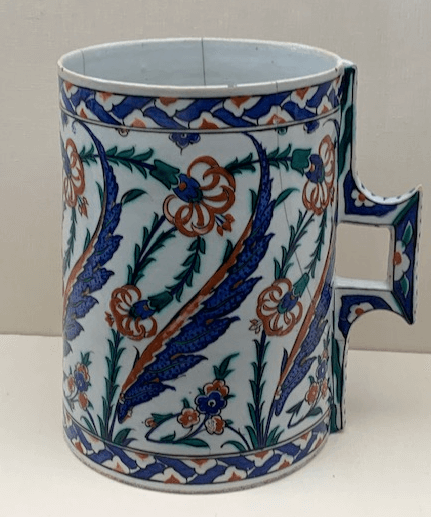
Jarro com flores (Turquia, séc. XVI)
Jug with flowers (Turkey, 16th century)

Jarro de farmácia (Persia , séc. XIV)
Pharmacy pitcher (Persia, 14th century)
Os azulejos decorados
Decorated tiles
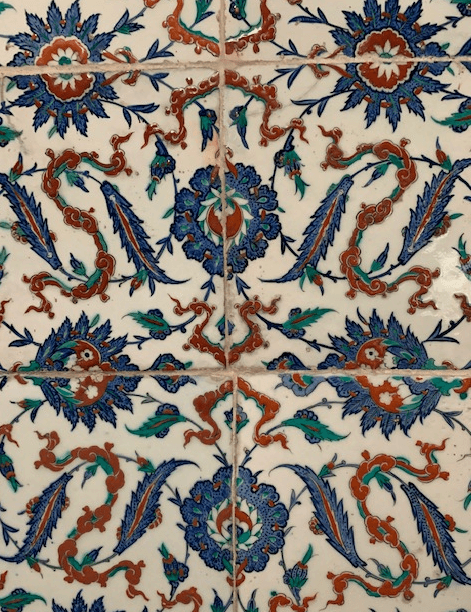
Painel de azulejos em padrão floral e nuvens, em cerâmica siliciosa pintada sobre vidrado (Turquia, sec. XVI)
Tile panel with a floral pattern and clouds, in siliceous ceramics painted on glaze (Turkey, 16th century)

Painel de azulejos em padrão floral e nuvens, em cerâmica siliciosa pintada sobre vidrado (Turquia, sec. XVI)
Tile panel with a floral pattern and clouds, in siliceous ceramics painted on glaze (Turkey, 16th century)

Painel de azulejos com cipreste ladeado de videiras, em cerâmica siliciosa pintada sobre vidrado (Turquia, sec. XVII)
Tile panel with cypress flanked by vines, in siliceous ceramics painted on glaze (Turkey, 17th century)
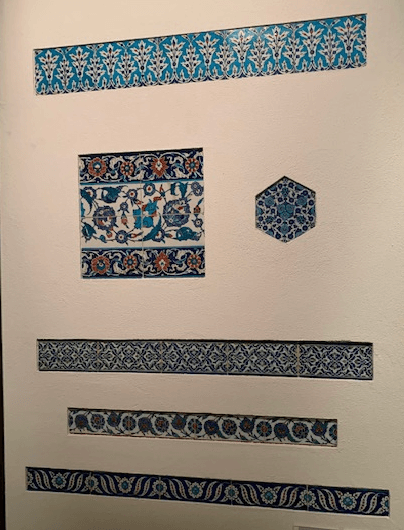
Molduras de azulejos em padrão floral em cerâmica siliciosa pintada sobre vidrado (Turquia, sec. XVI)
Siliceous ceramic tile frames in floral pattern painted on glaze (Turkey, 16th century)
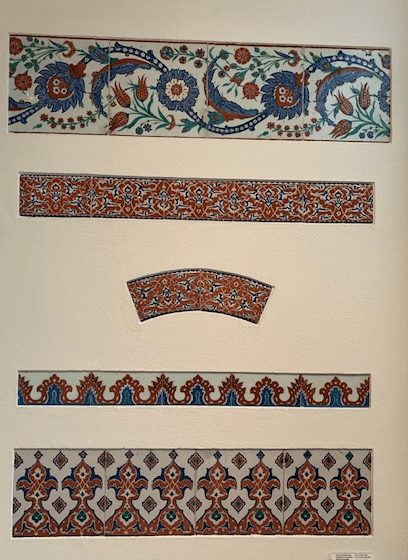
Molduras de azulejos em padrão floral em cerâmica siliciosa pintada sobre vidrado (Turquia, sec. XVI)
Siliceous ceramic tile frames in floral pattern painted on glaze (Turkey, 16th century)
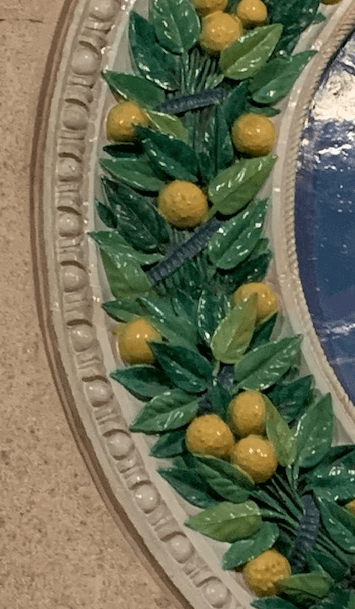
Detalhe de borda de azulejos (Turquia, sec. XVI)
Detail of tile border (Turkey, 16th century)
Espero que vocês tenham gostado deste meu olhar sobre o Museu Calouste Gulbenkian, em Lisboa, Portugal e que este blog seja uma grande fonte de inspiração para suas artes.
I hope you enjoyed my impressions of the Calouste Gulbenkian Museum in Lisbon, Portugal and use this blog as a source of inspiration for your arts.
Elizabeth Wiese
São Paulo, Março de 2023
São Paulo, March 2023
